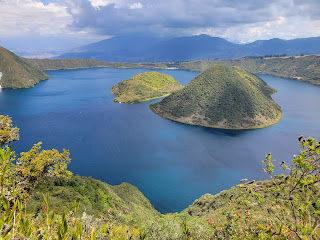I found Freddy on trip advisor and had been communicating with him for a few months. We wanted someone reliable to handle our longer ground transportation legs while on the mainland. We had a diversion planned over the next couple of days to go North for a nice looking hike, then check out the town of Otavalo with their famous market.
Freddy was fantastic.
He arrived on time as promised, and I was immediately at ease with him... friendly, very good (and at times, very funny) English skills, safe (slower as he spoke, lol) and super experienced. We were expecting a driver, we ended up getting a lovable tour guide that was super flexible, always listed to our feedback and really just took care of us.
As we eventually got out of Quito (he was astonished at the lack of traffic, even though today was one of the many independence days celebrated by Ecuador (today was the independence of Guayaquil)). In later days, we later found out what the meant by the traffic getting in and out of Quito.
Freddy started with the geographic layout of Ecuador (volcanos!) - naming all the big ones (and of course... they had the "tallest" mountain in the world)....
Chimborazo is still the highest mountain on Earth, at least when measured from the Earth's centre rather than sea level. Since our planet is a squashed sphere not a round one, and peaks close to the Equator get an extra few kilometres, Ecuador's tallest peak emerges supreme, the point on Earth closest to outer space.
Then of course, there's the tallest mountain in the world according to yet a different interpretation...
Though Mount Everest is the highest mountain on Earth at 29,032 feet above sea level, Maunakea Volcano on the Big Island of Hawaii actually holds the title of tallest mountain on Earth at 33,500 feet. More than half (19,698 feet) of Maunakea lies underwater, while 13,802 feet is above sea level.
Anything for a superlative... anyway... It's EVEREST!
The history Freddy and spoke about was really interesting, especially as I could now link it with what I learned about Peru. Our Colombia visit soon will complete that picture nicely!
Interestingly, Freddy talked about the racial history of his country this way... he pointed to different parts of his body "nose, ears, eyes, no hair on arms... that's indigenous... the hair that grows on my face... that's Spanish!". He said 70% or so of the country was this so called "mixed" race.
Beth napped while we continued the drive North. At about 10:30, we stopped and loaded up on some food before we started winding our way up into the foothills of the volcano we'd be hiking around. By 11, we'd registered and entered the park area for Lak Cuicocha.
Cuicocha (Kichwa: Kuykucha, "lake of guinea pigs" or Kuychikucha, "rainbow lake")[1] is a 3 km (2 mi) wide caldera and crater lake at the foot of Cotacachi Volcano in the Cordillera Occidental of the Ecuadorian Andes.
We didn't realize Freddy would be joining us, but it was awesome that he did. We spent the next 3 and a half hours climbing and descending on the 13km loop around the caldera, admiring the lake and trying to go slow and steady uphill so our breathing wouldn't get out of control. Like the Inca trail, Freddy reported that our moving time of just over three hours was quite quick, though it didn't seem to bad to me.
We say many Venezuelans on the road today... a continuation of the refugee problems they've been having for years, which is just now starting to affect the USA. Venezuelans are everywhere here - mostly trying to make money selling things on the street (ice cream was a popular choice, oddly), but Freddy explained the metrics... in Venezuela, they make $20/month - here they could make up to $5/day, so relatively, it was great. However, not all refugees were trying to make do by working, and sadly there are quite a few beggars and quite a bit of mostly petty crime - sadly this is what we saw the beginnings of in Peru in 2019.
On the hike, I started to think... what made most South and Central American countries progress so much more slowly in many ways compared with North America? We were "discovered" at the same time. Was it the Spanish/Portuguese influence vs the French/English? Was it the fact that South America was filled with people and riches that were to be exploited so much more than the relative sparsity and (perceived) lack of wealth in the North American indigenous people? Was it simply "corruption" and if so, why did that take hold? Style of government? Culture? It's kind of maddening when you start thinking about it.... One more thought... they sure seemed happy here.... maybe... more happy than us. Hmmm.....
We were zoning out by the time we got to our little hotel in Otavalo... We could have used a good hot tub. What a day. Otavalo seemed like a bustling little city when we had arrived, but by dinner, not much was open. We found a little local pizzeria with reasonably sized (ie like a local Ecuadorian woman!) $3 delicious pizzas.











No comments:
Post a Comment